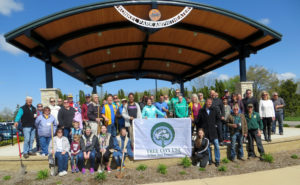 Right now, you’re probably sitting in your office, trying to stay warm and planning for the year ahead. Be sure to check out the following recognition programs and pass the information along to committee and boards who would be interested. The great part is that a single project could be used to help meet all three programs’ requirements! Also be sure to check out amazing trainings that are being offered throughout the state. Continue reading “Is your city a Bird, Bee or Tree City?”
Right now, you’re probably sitting in your office, trying to stay warm and planning for the year ahead. Be sure to check out the following recognition programs and pass the information along to committee and boards who would be interested. The great part is that a single project could be used to help meet all three programs’ requirements! Also be sure to check out amazing trainings that are being offered throughout the state. Continue reading “Is your city a Bird, Bee or Tree City?”
Urban Forestry News
Update on EAB in West Bend
Written in conjunction with Mike Jentsch, West Bend Parks and Forestry
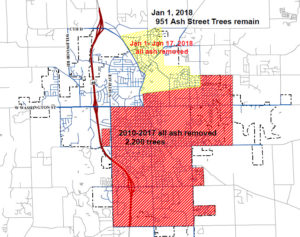 The city of West Bend is in Washington County, about a 30-minute drive north of Milwaukee. More than 32,000 people call West Bend home. Emerald ash borer was first confirmed in West Bend on June 9, 2010. The DNR Urban Forestry team previously showcased West Bend’s efforts to mitigate EAB in the city. We are showcasing West Bend again to show how their EAB efforts have changed as the pest grows and effects more and more trees. Their efforts can help shed light their hard work and guide communities that are just now being affected. Continue reading “Update on EAB in West Bend”
The city of West Bend is in Washington County, about a 30-minute drive north of Milwaukee. More than 32,000 people call West Bend home. Emerald ash borer was first confirmed in West Bend on June 9, 2010. The DNR Urban Forestry team previously showcased West Bend’s efforts to mitigate EAB in the city. We are showcasing West Bend again to show how their EAB efforts have changed as the pest grows and effects more and more trees. Their efforts can help shed light their hard work and guide communities that are just now being affected. Continue reading “Update on EAB in West Bend”
Showcasing Black History Month through urban wood utilization
If you’re near Wauwatosa, stop by and check out this urban wood art exhibit – Fresh Perspective Art Collective’s 2nd Annual “Urban Heroes, Urban Wood” Black History Month Show. Notable Black Milwaukeeans have painted and drawn on salvaged wood from Milwaukee’s ash trees. The exhibition runs from February 16 – March 16. For more information check out https://www.artsinmilwaukee.org/events/urban-heroes-urban-wood-2005.
For more information contact Ellen Clark, Urban Forestry Communication Specialist at (EllenA.Clark@wisconsin.gov) 608-267-2774.
WAA/DNR Annual conference registration
 The Wisconsin Arborist Association (WAA) teams up with the Wisconsin Department of Natural Resources to present the WAA/DNR Annual Conference, February 18-20, 2018 at the KI Convention Center in Green Bay, Wisconsin. This year’s theme is “Growing Arboriculture and Urban Forestry for Today and Tomorrow: From Fundamentals to Advanced Knowledge,” and registration for the conference is now open.
The Wisconsin Arborist Association (WAA) teams up with the Wisconsin Department of Natural Resources to present the WAA/DNR Annual Conference, February 18-20, 2018 at the KI Convention Center in Green Bay, Wisconsin. This year’s theme is “Growing Arboriculture and Urban Forestry for Today and Tomorrow: From Fundamentals to Advanced Knowledge,” and registration for the conference is now open.
Professional sports work to plant trees
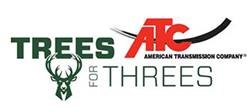 The Milwaukee Bucks and American Transmission Co. (ATC) are bringing back their “Trees for Threes” initiative for the 2017-18 Milwaukee Bucks season. Through the Trees for Threes platform, the Bucks and ATC will sponsor the planting of a new tree in Wisconsin for every 3-pointer the Bucks make at home this season.
The Milwaukee Bucks and American Transmission Co. (ATC) are bringing back their “Trees for Threes” initiative for the 2017-18 Milwaukee Bucks season. Through the Trees for Threes platform, the Bucks and ATC will sponsor the planting of a new tree in Wisconsin for every 3-pointer the Bucks make at home this season.
Continue reading “Professional sports work to plant trees”
Urban Forestry staff convene in Tulsa, OK
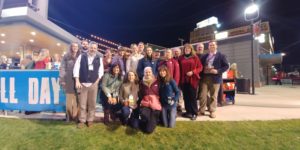 In November, two Urban Forestry team members, Alex Elias (Urban Forestry Grants Manager) and Ellen Clark (Urban Forestry Communications Specialist), attended the Partners in Community Forestry Conference in Tulsa, Oklahoma. The Partners in Community Forestry Conference is a two-day gathering for individuals, nation-wide from industry, non-profit, and state, local and federal agencies alike to come together and collaborate and share ideas, research and interests with others. The conference offered peer-to-peer learning opportunities and educational sessions regarding how to engage communities and partners to promote trees. The conference also fostered discussions regarding how to develop nationwide metrics and stories promoting urban forestry.
In November, two Urban Forestry team members, Alex Elias (Urban Forestry Grants Manager) and Ellen Clark (Urban Forestry Communications Specialist), attended the Partners in Community Forestry Conference in Tulsa, Oklahoma. The Partners in Community Forestry Conference is a two-day gathering for individuals, nation-wide from industry, non-profit, and state, local and federal agencies alike to come together and collaborate and share ideas, research and interests with others. The conference offered peer-to-peer learning opportunities and educational sessions regarding how to engage communities and partners to promote trees. The conference also fostered discussions regarding how to develop nationwide metrics and stories promoting urban forestry.
Continue reading “Urban Forestry staff convene in Tulsa, OK”
Welcoming a new team member
T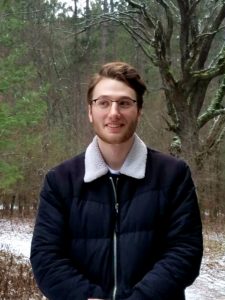 he Urban Forestry team has recently added a new member, Abner Jacobson. Abner will be an Urban Forestry Grant Specialist. Originally from the East Side of Madison, Abner graduated from the University of Wisconsin in 2017 with degrees in Communication Arts and Political Science. Continue reading “Welcoming a new team member”
he Urban Forestry team has recently added a new member, Abner Jacobson. Abner will be an Urban Forestry Grant Specialist. Originally from the East Side of Madison, Abner graduated from the University of Wisconsin in 2017 with degrees in Communication Arts and Political Science. Continue reading “Welcoming a new team member”
2018 Urban Forestry Grant recipients
By Alex Elias, Urban Forestry Grants Manager
Thirty communities, nonprofit groups and counties will share $465,661.99 in 2018 state grants from the Department of Natural Resources Urban Forestry Grant program to promote and sustain urban forest resources in Wisconsin.
Another productive year for WI Urban Forestry!
By Jeff Roe, Urban Forestry Team Leader
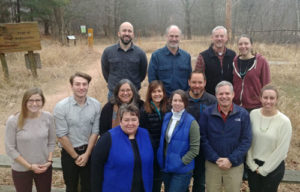 As I reflect on the last year, what stands out most for me is the great people that I work with – both staff and partners!
As I reflect on the last year, what stands out most for me is the great people that I work with – both staff and partners!
This has been a year of change, with new structures and leadership within the agency. Nonetheless, the staff dedication and leadership support for our program, and the work we do, remain strong. We have also had some staff changes this year: we added a new coordinator to the team, Brad Johnson, to serve the West Central area of the state; Bobbi and Dan joined the team to help with grants and the urban assessment program, respectively; and later in the year, Bobbi moved on to a full-time position within another DNR program. Continue reading “Another productive year for WI Urban Forestry!”
Evergreen: A Holiday History
By Dan Buckler, Urban Forest Assessment Specialist
The winter blues are not a modern phenomenon, but something that struck an existential chord in our ancestors. Luckily there were things growing in the forests which sparked hope in hearts until the sun returned, slowly but surely, at the winter solstice. Continue reading “Evergreen: A Holiday History”
